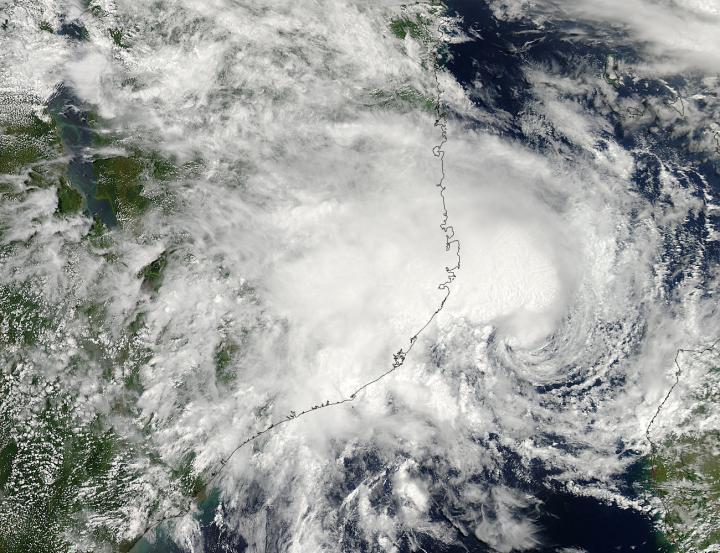NASA sees Tropical Cyclone 15S meandering in Mozambique Channel

NASA's Aqua satellite captured this visible image of Tropical Cyclone 15S on March 5 at 11:25 UTC (6:25 a.m. EST) when it was hugging the coast of eastern Mozambique. Image Credit: NASA Goddard MODIS Rapid Response Team
The storm's lack of direction is short-lived, however, as forecasters at the Joint Typhoon Warning Center or JTWC expect that the storm will move in a southwesterly direction and landfall in west central Madagascar by March 9.
The Moderate Resolution Imaging Spectroradiometer or MODIS instrument that flies aboard NASA's Aqua satellite captured a visible image of Tropical Cyclone 15S on March 5 at 11:25 UTC (6:25 a.m. EST) when it was hugging the coast of eastern Mozambique.
The MODIS image showed that the bulk of clouds and rain were north and west of the center of circulation, extending over the Mozambique coastline, while the center of Tropical Cyclone 15S remained over the open waters of the Mozambique Channel.
On March 6 at 1500 UTC (10 a.m. EST), Tropical Cyclone 15S was centered near 16.5 south latitude and 41.3 east longitude, about 349 nautical miles (401 miles/464 km) north-northeast of Europa Island.
Maximum sustained winds were still near 35 knots (40 mph/62 kph), but are expected to increase over the next two days as it moves away from Mozambique and into the open waters of the Mozambique Channel, toward Madagascar. At 1500 UTC, however, it was moving slowly at 2 knots (2.3 mph/3.7 kph) to the west-northwest.
Tropical Cyclone 15S is expected to make landfall in west central Madagascar's Tsingy de Bemaraha Strict Nature Reserve and move across the island nation in a southeasterly direction, with its center expected to pass just south of the capital city of Antananarivo before exiting the east coast early next week.
Media Contact
All latest news from the category: Earth Sciences
Earth Sciences (also referred to as Geosciences), which deals with basic issues surrounding our planet, plays a vital role in the area of energy and raw materials supply.
Earth Sciences comprises subjects such as geology, geography, geological informatics, paleontology, mineralogy, petrography, crystallography, geophysics, geodesy, glaciology, cartography, photogrammetry, meteorology and seismology, early-warning systems, earthquake research and polar research.
Newest articles

A universal framework for spatial biology
SpatialData is a freely accessible tool to unify and integrate data from different omics technologies accounting for spatial information, which can provide holistic insights into health and disease. Biological processes…

How complex biological processes arise
A $20 million grant from the U.S. National Science Foundation (NSF) will support the establishment and operation of the National Synthesis Center for Emergence in the Molecular and Cellular Sciences (NCEMS) at…

Airborne single-photon lidar system achieves high-resolution 3D imaging
Compact, low-power system opens doors for photon-efficient drone and satellite-based environmental monitoring and mapping. Researchers have developed a compact and lightweight single-photon airborne lidar system that can acquire high-resolution 3D…





















